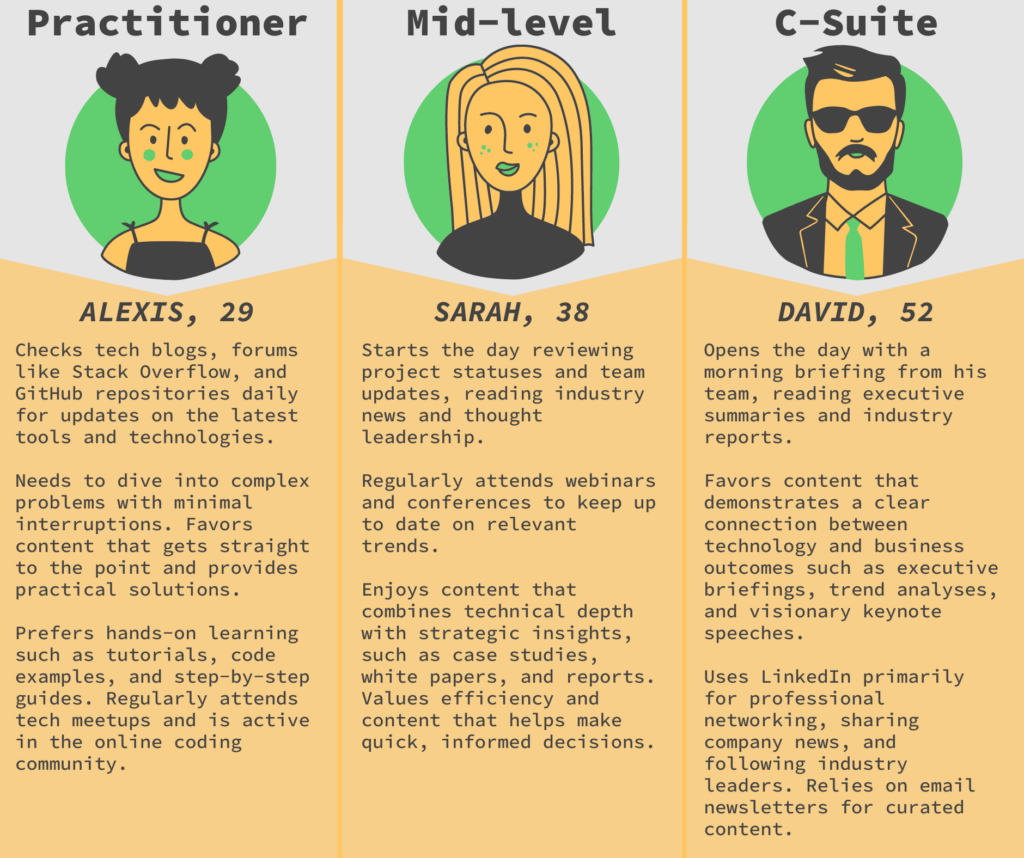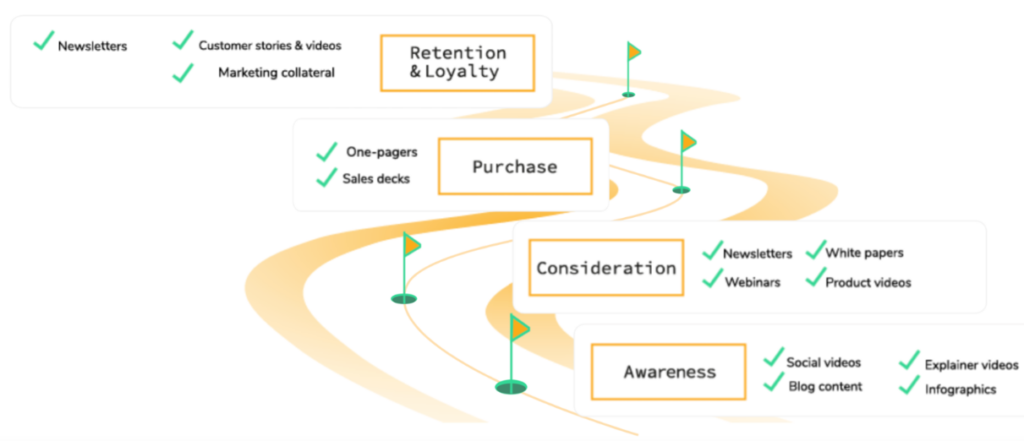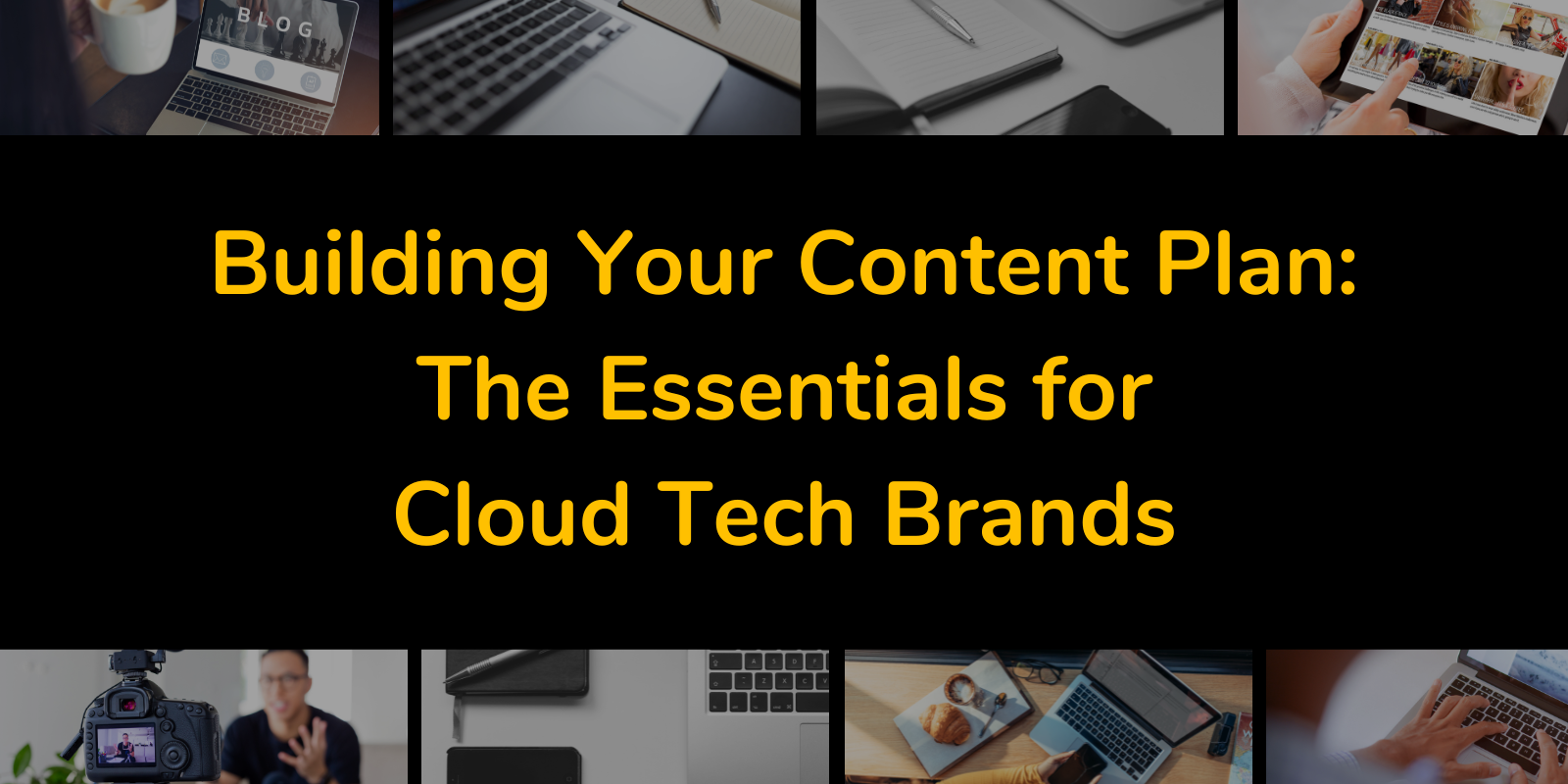A few years ago, I got a call from the CEO of a startup in the cloud security space in need of tech content. When I asked him who their target audience was and what they had in mind, he ran off a list of a dozen or so different target audiences—C-levels, IT managers, developers, and various ops and sales roles—and told me to get in touch with their newly hired marketing manager for more info.
At the meeting with the manager, I asked about their content plan, what type of content they hoped to produce, and how they intended to reach their target audiences.
He just looked at me with a blank stare, and it quickly became clear to me that he was completely new to the tech marketing role and to the brand. He hesitated for a moment and started throwing out generic, outdated, and overly general content topics like “Cloud Migration Best Practices” and “Top Ten Tools for Cloud Security.” These “fluff” topic ideas revealed that he had no sense of what the organization’s marketing goals were or the specific steps they needed to take to achieve them.
This is not the first time I’ve had this experience working with clients, and I’m sure it won’t be the last. And it’s not exclusive to startups; I’ve encountered this phenomenon both in early-stage ventures and in large enterprises that are specifically looking to gain a foothold in the growing dev/tech marketing field.
Whether you’re promoting a SaaS payroll or CRM solution, cloud data storage and analytics, or managed security services, you need a strategy and a well-defined content plan tailored to your audience that covers the entire buyer journey.
In this post, we’ll help you get started building such a content plan, including:
-
- Narrowing down your most important audiences
- Determining what types of content to include
- Identifying the stages of your audience journey
Based on our experience helping clients develop and execute effective tech content plans for a range of business sizes—all the way up to enterprise scale—let’s take a look at what each stage of your content plan needs to include.
Target Audience
Who are you creating content for?
While persona research is important and complex, for tech products and services, it usually boils down to three primary levels of audience you need to reach: C-suite, mid-level, and practitioner.
Each of these levels demands specific types of content; you must communicate differently to reach a CIO or a DevOps engineer.
Here’s a diagram showing the most important target audience personas for tech content marketing:

All three of these personas are essential:
1. Practitioner
Job titles at this level include: Software developer, QA engineer, DevOps engineer
You need this persona for bottom-up adoption—essentially, connecting with the people who are going to be your product’s end users.
To reach a practitioner, you need content that conveys extreme authenticity, authority, and in-the-trenches relatability. No time-wasting here.
Consider short, simple demos and other documentation to quickly convert them to dedicated users. With the rise in bottom-up adoption, this persona has become critically important for reaching B2B software vendors.
2. Mid-level
Job titles at this level include: Security team lead, product manager, IT/Ops manager
You need this persona because they make department-wide decisions and can also advocate across the entire organization.
You can reach a mid-level persona with content that promises more efficient workflows, team buy-in, and cohesiveness.
Another magic word here: integration.
3. C-suite
Job titles at this level include: CISO, CTO, CPO
You need this persona because they’re the ones who ultimately sign the checks.
You can share your message with this persona through content that conveys professionalism, competence, and an understanding of the bottom line. The C-suite needs to know that your organization is as solid as your technology and that you’ll be with them for support and perhaps expanded services for years to come.
Hint: One of the best ways to create content that speaks to all these different personas is with generative AI; not necessarily to write the copy, but to help you understand pain points, interests, and come up with ideas for deep content that will resonate with all these levels.
Tips for Target Audience
Here are a few ideas to help you get your target audience just right…
-
- Research and learn as much as you can about the audience you’re trying to reach: their needs, pain points, and goals. Try developer-specific forums like StackExchange and Reddit, chat on GitHub, or read up on similar products on rating sites like G2.
-
- Cultivate a deep understanding of market trends as well as the competitive landscape. G2 can help with this, as well as market- and audience-specific sites like HackerNews, Daily.dev (both for developers) or outlets like Krebs on Security or SecurityWeek for security professionals. Of course, it’s also essential to speak to subject-matter experts when it comes to finding out what’s going on in a specific industry.
-
- Listen and invite feedback wherever possible, whether from direct end users through tech support, surveys, or interviews; or from C-suite and mid-level executives through LinkedIn posts, business Twitter accounts, and other social media.
Types of Content
You’re already familiar with the types of tech marketing content available, such as technical blogs, video tutorials, webinars, research reports, datasheets, case studies, how-tos, and more. But how can each of these content types serve you most effectively—and at which stages in the audience journey?
Keep reading for more on the audience journey and how each content type fits in. At the very least, you’ll need a steady supply of the following three essential types of content.
1. Blogs
By sharing short, informative articles on a regular basis, blogs help you provide a variety of short and mid-length content to appeal to multiple audiences. Blogs also let you build content clusters that showcase your authority in your domain while taking your audience through the entire buyer journey, all the way to conversion.
For example, a vendor offering application security solutions might create a pillar called “The Ultimate Guide to Application Security Testing,” in which they link to content about traditional, code-based solutions like static application security testing (SAST) and dynamic application security testing (DAST), compare these with runtime solutions like interactive application security testing (IAST), and finally introduce product-specific content or a guide to choosing the right tool.
With a comprehensive content plan, all the content this vendor creates will work together effectively to not only build SEO but also educate audiences.
While some blog content can be more basic for casual visitors, some should dive deep into narrow and specific topics—like a single new feature following a recent upgrade of an open-source package. This type of content appeals to tech practitioners, and will convince them of your expertise in their domain.
2. White Papers
These formal, often gated reports—gating provides you with valuable information about prospective leads—establish thought leadership by deeply exploring industry trends and solutions.
White papers usually target C-level executives, such as a vendor of an endpoint detection and response (EDR) solution using a white paper to dissect evolving threats and showcase the benefits of their AI-powered solution.
This positions you as experts, educates C-levels, and subtly nudges them toward considering your solution—a potent combination for driving sales and brand recognition.
This format may be less relevant to security professionals, who would need more information—such as a video tutorial—highlighting how easy the platform is to work with or how it filters out false positives and meaningless alerts.
3. Case Studies
These offer social proof: real-world use cases where your product or service helped customers resolve a problem or achieve a goal. Case studies boost your credibility, encouraging potential customers to trust in your ability to deliver what they need.
(Example: “How Company XYZ Used Cloud Computing to Improve Customer Service”)
4. Explainer Videos
Explainer videos are ideal for reaching audiences with short attention spans. Using engaging visuals and concise storytelling, they offer clear and concise explanations to quickly and effectively convey complex information or concepts and to get prospective customers moving in the right direction.
Check out this explainer video on proxy servers that IOD created for Bright Data.
Quick Tips for Content Type
-
- Establish separate pipelines and content types for top-down and bottom-up audiences. Content suitable for a CIO, which tends to be high level, such as white papers that focus on benefits to the organization like ROI, won’t necessarily resonate with a cloud architect or DevOps engineer who are looking for tools and platforms to make their everyday workflow simpler or safer. For those audiences, a quick demo or a short, task-focused blog post, would better hold their attention. To succeed today, you need to speak to both audiences.
-
- Track metrics such as video completion rate, which lets you know who’s watching a video all the way through. For text-based content, similar engagement metrics can track time on page and scrolling; tools such as TrenDemon can help you focus your efforts in this area.
Audience Journey
Regardless of the persona you’re trying to reach with a specific content asset, you must consider what stage of the audience journey that persona is in:
-
- Map out the big-picture journey that your target audience will take, from absolute beginner to die-hard evangelist.
-
- Identify the different stages of the audience journey: awareness, consideration, purchase, retention, and loyalty.
-
- Create content that is relevant to each stage of the audience journey.

This journey consists of four stages:
1. Awareness
The buyer has identified a problem that is preventing them from working effectively. They are now actively seeking a solution.
For example, a mid-level DevOps engineer might realize their dev team is spending significant time on provisioning and configuring infrastructure. This is wasting a lot of their time and leading to errors and inconsistencies because they’re doing it all manually.
2. Consideration
The buyer now understands what the problem is and starts looking around for a solution, usually online.
In this case, the DevOps engineer realizes that manually configuring infrastructure is draining resources. They look around for a solution, perhaps attend a webinar, and realize that infrastructure as code (IaC) could save time and prevent errors.
3. Purchase
This is sometimes also known as the “decision” stage because a previously undecided prospect has decided to go ahead and choose a solution. The only question here is: Which solution will be the best fit for their organization?
In this case, our DevOps engineer weighs the benefits of various IaC tools (Terraform, Ansible, AWS CloudFormation, and many more) to see which works best with their current tech stack. Ultimately, they make a purchase and roll it out.
4. Retention & Loyalty
This stage is often forgotten, but it’s crucial not only to ensure ongoing income but increase upsell potential. This stage can also help turn ordinary users into passionate evangelists for your solution.
The DevOps engineer might share early questions in forums or seek out detailed how-tos to get up and running quickly, along with documentation to help them discover new use cases for the solution.
Tips for Audience Journey
-
- At any stage, but especially early in the journey, sounding salesy is not acceptable. Words like “innovative,” “revolutionary,” or “advanced” are fluff that say nothing about your product or solution. If they’re true, you need to show your audience through demos, case studies, or testimonials rather than wasting time telling them.
-
- Plan all content around a central brief that includes fields like “Audience proficiency level,” “Goals,” and “Call to action.” This may seem obvious, but in our experience, even many senior marketers jump into creating content without this step in place.
-
- Make any communication about them, not about you. Focus on pain points, benefits, and simple solutions to common problems. For example, when you’re marketing to security professionals, it helps to understand that they’re inundated with multiple alerts from a range of applications: endpoint detection and response, security information and event management (SIEM), vulnerability scanners, cloud security tools, identity and access management (IAM) systems, and many more. Knowing this, you could explain how your solution will help them consolidate alerts, discard irrelevant alerts, and automate or otherwise simplify their response while still keeping their organization highly secure and safe.
-
- Create content that’s about more than just conversion. Yes, turning casual readers or viewers into users is an essential job of tech content marketing, but you need to create content in parallel to support every stage of the audience journey. Plus, some content can support more than a single stage. Case studies, for example, can aid in retaining existing users by demonstrating the potential for additional use cases or add-ons.
-
- Make it easy to say yes. Show how your offering stacks up and offer no-commitment ways to convert casual browsers (those early on in the audience journey), like a free trial or high-value webinar; this shouldn’t be a sales pitch, but a genuine opportunity to learn from industry pros! A case study or statistics on how other customers managed to cut costs, save time and resources, gain visibility into their assets, or eliminate alert fatigue will go a long way towards convincing other people in the organization to approve the purchase.
Building a Winning Tech Content Plan
Determining your target audience, choosing content types, and tailoring content throughout the funnel are only part of what it takes to build an effective tech content strategy.
You also need access to the right people: subject matter experts, tech marketing writers and strategists, technical editors, and video professionals. You need a strict editorial and review process in place in order to ensure technical accuracy and alignment with your brand messaging. And you need to choose the appropriate distribution channels.
While your organization’s plan will vary based on factors like your budget, resources, and publishing schedule, once you’ve streamlined this process, you’ll be able to generate quality technical content at a regular cadence and at scale.
Back to the cloud storage startup mentioned at the beginning of this blog. In close collaboration with the marketing manager, IOD worked as an extension of the company’s marketing team, helping with content strategy and planning, conducting brainstorming sessions, choosing topics and producing a variety of content types tailored to each of their target audiences.
A few months into our partnership, I got a call from the manager. He happily reported that not only were they getting 10x more organic traffic to their site, they were also generating quality leads and conversions. That’s what a customized tech content plan can do.
In this post, we’ve explored some of the most important aspects of creating a content plan for your cloud brand. Keep an eye out for the next blog posts in this series, where we take a deeper dive into some of the topics covered here.
And be sure to check our free ebook, Cloud Computing 101: The Ultimate Guide for Tech Marketing Writers.
Streamline your tech content production, become a thought leader in your field, and drive results. Tap into IOD’s vast network of tech experts, writers, strategists, designers, and video professionals.

